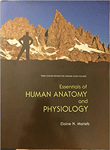
Essentials of Human Anatomy and Physiology (Custom)
15th Edition
ISBN: 9781269752862
Author: Marieb
Publisher: PEARSON
expand_more
expand_more
format_list_bulleted
Question
Chapter 15, Problem 20SAE
Summary Introduction
To review:
The mechanism by which the chemical buffer systems resist changes in pH.
Introduction:
A buffer system is a solution that resists a change in pH due to addition of acids or bases. There are three main buffer systems in the body: phosphate system, bicarbonate system, and the protein system. They maintain the pH and work together by resisting the change in pH in various fluid compartments.
Expert Solution & Answer
Want to see the full answer?
Check out a sample textbook solution
Students have asked these similar questions
18. Watch this short youtube video about SARS CoV-2 replication. SARS-CoV-2 Life Cycle (Summer 2020) - YouTube.19. What is the name of the receptor that SARS CoV-2 uses to enter cells? Which human cells express this receptor? 20. Name a few of the proteins that the SARS CoV-2 mRNA codes for. 21. What is the role of the golgi apparatus related to SARS CoV-2
State the five functions of Globular Proteins, and give an example of a protein for each function.
Diagram of check cell under low power and high power
Chapter 15 Solutions
Essentials of Human Anatomy and Physiology (Custom)
Ch. 15 - More than one choice may apply. Microscopic...Ch. 15 - Prob. 2MCCh. 15 - Prob. 3MCCh. 15 - Effects of aldosterone include a. increase in...Ch. 15 - 5. Which of the following is dependent on tubular...Ch. 15 - Prob. 6MCCh. 15 - The smallest fluid compartment is the a....Ch. 15 - Prob. 8MCCh. 15 - Prob. 9SAECh. 15 - Prob. 10SAE
Ch. 15 - Prob. 11SAECh. 15 - Identify the main blood vessels that drain blood...Ch. 15 - Prob. 13SAECh. 15 - Prob. 14SAECh. 15 - Prob. 15SAECh. 15 - Prob. 16SAECh. 15 - Prob. 17SAECh. 15 - What is the juxtaglomerular apparatus and what is...Ch. 15 - Prob. 19SAECh. 15 - Prob. 20SAECh. 15 - Prob. 21SAECh. 15 - Prob. 22SAECh. 15 - Prob. 23SAECh. 15 - Prob. 24SAECh. 15 - 25. What sometimes happens when urine becomes too...Ch. 15 - Define incontinence.Ch. 15 - Why is cystitis more common in females?Ch. 15 - 29. What type of problem most commonly affects the...Ch. 15 - Prob. 29SAECh. 15 - Prob. 30CAQCh. 15 - Prob. 31CAQCh. 15 - A young woman has come to the clinic with dysuria...Ch. 15 - 34. What happens to the rate of RBC production in...Ch. 15 - Two physiology students are having a disagreement...Ch. 15 - Mr. Jessup, a 55-year-old man, is operated on for...
Knowledge Booster
Learn more about
Need a deep-dive on the concept behind this application? Look no further. Learn more about this topic, biology and related others by exploring similar questions and additional content below.Similar questions
- a couple in which the father has the a blood type and the mother has the o blood type produce an offspring with the o blood type, how does this happen? how could two functionally O parents produce an offspring that has the a blood type?arrow_forwardWhat is the opening indicated by the pointer? (leaf x.s.) stomate guard cell lenticel intercellular space none of thesearrow_forwardIdentify the indicated tissue? (stem x.s.) parenchyma collenchyma sclerenchyma ○ xylem ○ phloem none of thesearrow_forward
- Where did this structure originate from? (Salix branch root) epidermis cortex endodermis pericycle vascular cylinderarrow_forwardIdentify the indicated tissue. (Tilia stem x.s.) parenchyma collenchyma sclerenchyma xylem phloem none of thesearrow_forwardIdentify the indicated structure. (Cucurbita stem l.s.) pit lenticel stomate tendril none of thesearrow_forward
- Identify the specific cell? (Zebrina leaf peel) vessel element sieve element companion cell tracheid guard cell subsidiary cell none of thesearrow_forwardWhat type of cells flank the opening on either side? (leaf x.s.) vessel elements sieve elements companion cells tracheids guard cells none of thesearrow_forwardWhat specific cell is indicated. (Cucurbita stem I.s.) vessel element sieve element O companion cell tracheid guard cell none of thesearrow_forward
arrow_back_ios
SEE MORE QUESTIONS
arrow_forward_ios
Recommended textbooks for you
 Human Physiology: From Cells to Systems (MindTap ...BiologyISBN:9781285866932Author:Lauralee SherwoodPublisher:Cengage Learning
Human Physiology: From Cells to Systems (MindTap ...BiologyISBN:9781285866932Author:Lauralee SherwoodPublisher:Cengage Learning Human Biology (MindTap Course List)BiologyISBN:9781305112100Author:Cecie Starr, Beverly McMillanPublisher:Cengage Learning
Human Biology (MindTap Course List)BiologyISBN:9781305112100Author:Cecie Starr, Beverly McMillanPublisher:Cengage Learning Biology 2eBiologyISBN:9781947172517Author:Matthew Douglas, Jung Choi, Mary Ann ClarkPublisher:OpenStax
Biology 2eBiologyISBN:9781947172517Author:Matthew Douglas, Jung Choi, Mary Ann ClarkPublisher:OpenStax


Human Physiology: From Cells to Systems (MindTap ...
Biology
ISBN:9781285866932
Author:Lauralee Sherwood
Publisher:Cengage Learning


Human Biology (MindTap Course List)
Biology
ISBN:9781305112100
Author:Cecie Starr, Beverly McMillan
Publisher:Cengage Learning


Biology 2e
Biology
ISBN:9781947172517
Author:Matthew Douglas, Jung Choi, Mary Ann Clark
Publisher:OpenStax
Serology 101: Testing for IgG and IgM antibodies; Author: Beckman Coulter Dx;https://www.youtube.com/watch?v=LtqKB-qpJrs;License: Standard youtube license